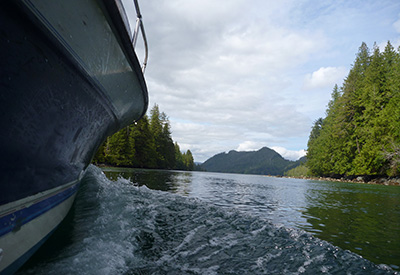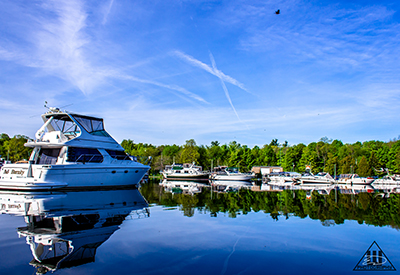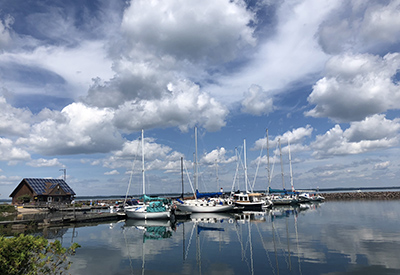1000 Islands – A Thousand Good Reasons

I first discovered the Thousand Islands three days into a CYA sailing course that was basically a boat camp for sailors.
It was the end of September. We’d been underway twenty-four hours a day. Our skipper/instructor finally took mercy on us – no doubt persuaded by the odiferous crew – and instructed us to tie up to a dock at Mermaid Island in St. Lawrence Islands National Park.
The leaves were just beginning to turn – blushing maples, oak leaves gilded in gold.
I dove into crystal waters, floating lazily, staring out at the sun falling into the west, its rays burnishing the waters of the St. Lawrence.
Looking for respite from both the peccadilloes and the aroma of my crewmates, I towelled off, changed into warmer clothes and climbed a granite ridge. I found a spot atop a fifteen-metre cliff and watched the day decay into night, lights on the cottages on the nearby islands twinkling like Santa’s eyes.
I was smitten.
If I’d ever needed a reason to come back to the Thousand Islands, I’d just discovered it in no uncertain terms.
A thousand good reasons, to be precise.
Fast forward to a perfect August morning, my wife and I trudging along a gravel road above Chippewa Bay in the eastern reaches of the island chain. The road turns back and forth on itself, at last opening up on a rolling meadow.
On the right side of the road tall grasses sway in the breezes scurrying along the river, twenty shades of green punctuated by an explosion of wildflowers. Purple loosestrife, goldenrod, white lady’s slippers.
It is the perfect foreground for a perfect picture.
And one more good reason.
Background is a necklace of islands carved from granite, strewn like jewels across sapphire waters. The current etches a mosaic of patterns onto the surface. Blue skies and inverted pine and cedar trees are mirrored in the places the current bypasses.
A rustic cottage dominates one island. A Victorian mansion with dormered windows, wraparound porches, a massive boathouse, teal-painted clapboard facades with butter-coloured trim and twin towers, capped by candle-snuffer roofs, holds court on another.
A castle with turrets rises up from Dark Island, boasting an electrical plant designed by Thomas Edison, secret passageways, a dungeon. A slice of Europe snugged down in the current of one of North America’s premier waterways, a body of water as full of history as it is full of boaters.
And as full of surprises.
Anywhere else in North America a castle would be an anachronism. Anywhere else the juxtaposition of blue water, green forest and these turrets would jar the senses.
But not here. Here the castle works. And there’s even a nautical connection. Gilbert Bourne, one-time president of the Singer Sewing Machine Company, commissioned its construction. He was once the commodore of the New York Yacht Club.
And Singer Castle isn’t the only – or even most famous castle – here. Boldt Castle, near Alexandria Bay, sees more yearly visitors and is a quick cruise from Alexandria Bay or Gananoque.
Nor are these fairy-tale constructs the only startling anomalies.
One morning we see two sea kayakers, one green, one yellow, sharing wind-ruffled waters with a three-hundred-metre-long freighter, beside a sailboat, beside a mahogany runabout riding the wake of a great white tour boat.
All on a thousand-kilometre water route known as the St. Lawrence. Gateway to Canada, guardian of North America.
But it’s not just the sheer scope of the river that makes the area such an attractive cruising ground. This waterway cradles more than a millennium of islands.
“They’re the extremely ancient roots of mountains,” says Don Ross, a Hill Island resident and the author of Discovering the Thousand Islands. They form a geological bridge that connects the heights of the Canadian Shield to the Adirondacks, an arch of granite that almost, but not quite, blocks the easterly flow of water from the Great Lakes.
“Actually closer to eighteen hundred islands,” says former Thousand Islands tourism representative, Suzanne Bixby. “Some we haven’t even counted. Supposed to have two trees and supposed to be above water all year.”
One day, Ron Mowers, a resident of Tennis Island and skipper of a beautifully-maintained Egg Harbor 33’ named “19th Hole,” pilots us on a nautical tour of the archipelago. From the flying bridge, Mowers points at a little island near Boldt Castle. It has one tree.
“Doesn’t qualify,” says Bixby, who’s come along for the ride.
But more than a thousand do.
On another journey here we ply these waters in a runabout skippered by Don Ross himself; I discover even more reasons to love the place.
I’m a history buff. This is history’s haven.
The Battle of the Thousand Islands was waged here in 1760 between the British and the French. Ross skippers us into a serpentine channel bedecked by granite boulders and wind-crippled pines. “The French lured the British into this passage,” he says. “The British lost the wind and steerageway. The French pounded their ships.”
The island names are eloquent testimony to that bellicose past. The Navy Islands bear the names of ship captains from the British Navy; the Admiralty group memorializes different admirals. Death Dealer, Camelot, Dumbfounder and Endymion are all named for British warships. The Brock Island group and Wolfe, the biggest island here, are both named for British generals.
But the islands themselves only tell part of the history.
Kingston offers it up like a gourmet meal. Tour a penitentiary museum, learn the art of war at a Martello tower, a fortification unique to this region, and visit Old Fort Henry or the Bellevue House, the restored one-time residence of John A. MacDonald. Check out the Marine Museum of the Great Lakes right on the shores of Lake Ontario and stroll through a Coast Guard ice-breaker.
Alexandria Bay on the American side began life as a lumber trade site. It sported a wealth of wharves around the 1830s and was recognized as a tourist must-do when Ulysses Grant visited nearby Pullman Island in 1872.
Explore the Cornwall Brothers store, built in 1829 and now an interesting museum, or take a historic walking tour of this village down by the riverside.
Clayton, also on the American side, offers a wealth of period architecture, much of it reflecting the importance of the river to trade. Store fronts are refurbished to period authenticity and are uniquely positioned: open to the water as much as to the street, boasting plate glass windows at both ends – street side and water side. A variety of patios and balconies overlook the river. These buildings offer a multitude of delights to shoppers – from gift shops to antique galleries to a couple of great art galleries.
Take a historic walking tour here or visit one of the three museums. The Antique Boat Museum offers unforgettable glimpses of the history of boating in general and insight into the role that recreational boating has always played on these waters.
But a love of history isn’t the only – or even the best – reason to go ashore.
Alexandria Bay – locals call it “A Bay” – boasts more than its share of establishments offering up liquid libations to a multitude of boaters – and a party atmosphere that makes it well worth a visit. Just make sure you book an overnight berth. You will not want to leave until morning – if then.
Sip a cool one in the Caribbean ambiance of the lounge at Dock by the Bay or stretch out on the patio beside the pier beneath brightly coloured umbrellas. Stroll across the street and admire the view from Top of the Bay with its battleship-grey railings and two-leveled deck and its own small dock. Check out The Islander or Pirates’ Pub. Or pull into Skiffs, with its horseshoe-shaped bar and a Jolly Roger flag hanging over the bandstand, where you can get a glass of wine and a large beer with free peanuts – and receive change from your ten-dollar bill. “Just throw the shells on the floor,” quips the bartender.
Then there’s Kingston. Hit ten different pubs in one night, each a walk from your berth at Confederation Basin. Sip beer brewed onsite at Kingston Brewing Company or sample one or two or three from a selection of thirty different whiskeys at Tir nan Og.
Next morning redeem yourself by imbibing in a bit of culture. Kingston’s got its own symphony orchestra, a blues festival, the annual Buskers’ Rendezvous.
Or head east to Gananoque – locals call it “Gan” – and catch a live show at the Summer Playhouse Theatre.
But the best reasons to visit here are still nautical: all else is but icing on the cake.
Last summer we ventured here yet again, to be regaled by the sight of a conflagration of white sails, graceful and plentiful as a flock of seagulls, the entire horizon line decorated with a plethora of dinghies participating in the annual CORK Regatta off Kingston.
It’s incontrovertible evidence of this area’s primacy as a boater’s playground, if not one of the world’s best freshwater cruising areas.
During our boat ride with Don Ross we pass an anchorage at Endymion Island. Ross slows the boat. Set against a background of evergreen forest, three or four mooring balls bob in the gentle waves. A heron stands in the shallows like a Renaissance statue.
“This is what it’s all about,” says Ross. “More anchorages than dock spaces. Maybe three hundred transient berths. More than two thousand anchorages.”
Other local favourites include Thwart way (Leek) Island, Brakey Bay south of Howe and the east side of Mulcaster. Then again, given the numbers Ross tosses around, you’ll have no trouble finding your own.
If you’re looking for a compromise you “could still find a dock in great natural settings,” says Bixby. “On the Canadian side a number of spots in the St. Lawrence Islands National Park offer dockage with some facilities. You can berth at a marina at Wellesley Island or Keewaydin State Park.”
Or simply drop the hook in a bay to call your own, get out your book, hoist your hammock, then while away an evening soothed by the scent of pine.
We spend the last evening of our last visit here ensconced on a balcony overlooking the parade ground at Old Fort Henry. It’s the Wednesday sunset ceremony, held all summer in the limestone citadel guarding both the approaches to Kingston itself and the vanguard of a regiment of islands scattered to our east.
From the ramparts on the fort’s southeast walls you can see trees clinging desperately to barren lichen-painted humps of granite on Cedar Island, defined by the red roof and squat walls of a defensive Martello tower, fortified companion sentinel to the fort itself.
We’ve already been serenaded by a local community band; we’ve had ringside seats to a mock conflict, the flashes from muskets like fireflies in the night sky. Cannon blasts have reverberated across the square, swathing the red-coated soldiers in blue-grey smoke.
And now the lights dim, leaving a lone spotlight focused on a bagpiper standing high on the fortress walls.
The eerie lament causes a sudden tightness in my chest, a sense of pride in my heritage, a sense of awe at the sights we’ve seen, at the richness of this archipelago we’ve experienced this week – a microcosm of all that is Canada itself.
The piper launches into an eventide hymn. The flag is lowered, a bugle calls out.
The crowd is silent here where Lake Ontario meets the St. Lawrence, where a smattering of out islands – Howe and Wolfe and Amherst – melds seamlessly into a thousand others.
The crowd rises as one person. We sing “O Canada” in harmony.
The last stirring chord echoes through the walls of the citadel.
I realize, listening to the last dying tones, that I have discovered yet another great reason – but one more in a multitude of convincing excuses – to come back to the Thousand Islands.
Again and again and again.
By Mark Stevens Photographs by Sharon Matthews-Stevens





























